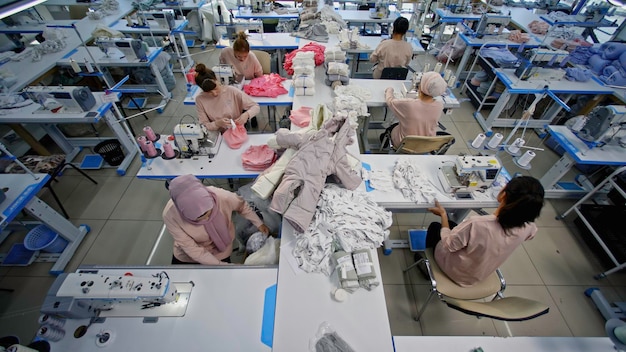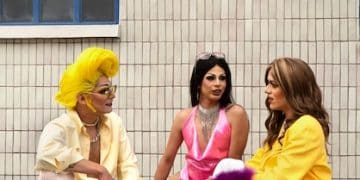The Ethics of Fashion: Are Brands Truly Protecting Workers and the Environment?

The Ethics of Fashion: Are Brands Doing Enough to Protect Workers and the Environment? Despite growing awareness, concerns persist about labor practices, environmental impact, and the overall sustainability of the fashion industry. Many question if current brand actions genuinely address these critical issues.
The fashion industry, known for its glitz and glamour, often hides a darker side. From sweatshops to environmental pollution, the ethical implications of our clothing choices are becoming increasingly clear. The question we must ask is: the ethics of fashion: are brands doing enough to protect workers and the environment?
This article delves into the heart of this issue, exploring the challenges and examining whether current efforts are sufficient to create a truly sustainable and ethical fashion industry.
The State of Fashion Ethics Today
The fashion industry’s ethical issues are complex and multifaceted, encompassing labor rights, environmental impact, and supply chain transparency. Understanding the current landscape is crucial to assessing whether brands are truly doing enough.
From fast fashion’s rapid production cycles to the sourcing of raw materials, ethical concerns permeate every stage of the value chain.
Labor Exploitation in the Fashion Industry
Exploitation of garment workers remains a significant ethical challenge. Many factories, particularly in developing countries, continue to operate under harsh conditions with low wages and long hours.
- Unsafe Working Conditions: Factories often lack proper safety measures, putting workers at risk of accidents and health problems.
- Low Wages: Garment workers frequently earn below the living wage, struggling to meet basic needs.
- Forced Labor and Child Labor: In some cases, forced labor and child labor are still prevalent in the fashion supply chain.

Environmental Impact of Fashion
The environmental cost of fashion is substantial, with significant impacts on water resources, pollution, and climate change. Some of the most pressing issues include:
- Water Pollution: Textile dyeing and finishing processes release harmful chemicals into waterways, polluting ecosystems and endangering communities.
- Textile Waste: Fast fashion contributes to massive amounts of textile waste, much of which ends up in landfills.
- Carbon Emissions: The production and transportation of clothing contribute to greenhouse gas emissions and climate change.
Addressing these issues requires a holistic approach, focusing on sustainable materials, circular economy models, and responsible production practices. The **ethics of fashion: are brands doing enough to protect workers and the environment?** is a multi-layered question.
Brand Initiatives: A Closer Look
Many fashion brands have launched initiatives aimed at improving their ethical and environmental performance. However, the effectiveness and scope of these efforts vary widely.
While some brands are leading the way with comprehensive sustainability programs, others are accused of greenwashing or making token gestures that fail to address the root causes of the problems.
Sustainable Material Sourcing
Some brands are investing in sourcing sustainable materials, such as organic cotton, recycled polyester, and innovative new fibers like those made from seaweed or pineapple leaves. The purpose being to improve **the ethics of fashion: are brands doing enough to protect workers and the environment?**
However, scaling up the use of sustainable materials remains a challenge, due to cost, availability, and the need for traceability throughout the supply chain.
Fair Labor Practices and Auditing
Many brands conduct audits of their supplier factories to assess working conditions and ensure compliance with labor standards. However, audits are often criticized for being superficial and ineffective.
- Lack of Transparency: Audit reports are rarely made public, making it difficult to assess their credibility.
- Focus on Compliance: Audits often focus on ticking boxes rather than addressing systemic issues.
- Short-Term Fixes: Factories may temporarily improve conditions to pass audits, only to revert to прежние practices afterward.

Circular Economy Models
Some brands are experimenting with circular economy models, such as clothing rental, resale, and recycling programs. These initiatives aim to extend the life of clothing and reduce waste.
While these models show promise, they are still in their early stages and face challenges in terms of scalability and consumer adoption. The current scale does not yet significantly effect **the ethics of fashion: are brands doing enough to protect workers and the environment?**
Brands are implementing initiatives, but assessing their true impact requires critical evaluation and a focus on transparency and accountability.
The Role of Consumers and Advocacy Groups
Consumers and advocacy groups play a crucial role in holding brands accountable and driving change in the fashion industry.
By demanding transparency, supporting ethical brands, and advocating for policy changes, consumers can influence corporate behavior and promote a more sustainable and just fashion system. The effect on the ethics of fashion: are brands doing enough to protect workers and the environment? is significant.
Consumer Demand for Ethical Fashion
Consumers are increasingly aware of the ethical and environmental impacts of their clothing choices and are seeking out brands that align with their values.
However, ethical fashion is often more expensive, less accessible, and harder to find, creating barriers for many consumers.
Advocacy and Activism
Advocacy groups and activists are working to raise awareness, pressure brands to improve their practices, and push for stronger regulations. In order to improve **the ethics of fashion: are brands doing enough to protect workers and the environment?**, pressure is key.
These efforts include campaigns targeting specific brands, publicizing reports on labor and environmental abuses, and lobbying governments to enact stricter laws.
Transparency and Traceability
Consumers and advocacy groups are demanding greater transparency and traceability in the fashion supply chain. They want to know where their clothes are made, who made them, and under what conditions.
- Supply Chain Mapping: Brands need to map their entire supply chain, from raw materials to finished goods, and disclose this information to the public.
- Worker Empowerment: Workers need to have a voice in shaping labor standards and monitoring compliance.
- Independent Verification: Independent organizations should verify brands’ ethical and environmental claims. Asking **the ethics of fashion: are brands doing enough to protect workers and the environment?** is an important first step.
Consumers and advocacy groups are vital in holding brands accountable, demanding transparency, and driving systemic change towards a more ethical and sustainable fashion industry.
The Future of Fashion Ethics
The future of fashion ethics depends on a combination of factors, including technological innovation, policy changes, and shifts in consumer behavior.
By embracing new technologies, implementing stronger regulations, and fostering a culture of conscious consumption, we can create a fashion industry that is both stylish and sustainable. It is important that we continue to ask **the ethics of fashion: are brands doing enough to protect workers and the environment?**.
Technological Innovation
New technologies, such as blockchain, AI, and digital traceability tools, have the potential to transform the fashion supply chain and improve transparency and accountability.
These technologies can help track the origin of raw materials, monitor working conditions in factories, and verify ethical and environmental claims.
Policy and Regulation
Governments can play a crucial role in promoting fashion ethics by enacting stronger regulations on labor practices, environmental protection, and supply chain transparency.
- Mandatory Due Diligence: Companies should be required to conduct due diligence to identify and address human rights and environmental risks in their supply chains.
- Extended Producer Responsibility: Brands should be responsible for the end-of-life management of their products, incentivizing them to design for durability and recyclability.
- Trade Agreements: Trade agreements should include provisions on labor rights and environmental standards.
Shifting Consumer Values
A fundamental shift in consumer values is needed to drive long-term change in the fashion industry. Consumers need to prioritize quality over quantity, durability over disposability, and ethics over aesthetics.
This requires a cultural shift away from fast fashion and towards a more mindful and intentional approach to consumption.
The future of fashion ethics hinges on technological innovation, policy changes, and a fundamental shift in consumer values towards a more sustainable and responsible approach.
Conclusion
Ultimately, addressing the ethical challenges in the fashion industry requires a collaborative effort from brands, consumers, governments, and advocacy groups.
While some progress has been made, much more needs to be done to ensure that the fashion industry is truly protecting workers and the environment. So, **The Ethics of Fashion: Are Brands Doing Enough to Protect Workers and the Environment?** The answer is, progress is being made but more is needed.
| Key Aspect | Brief Description |
|---|---|
| 🌍 Environmental Impact | Water pollution, textile waste, and carbon emissions need urgent solutions. |
| 🧑🤝🧑 Labor Exploitation | Workers face unsafe conditions and low wages, especially in developing nations. |
| ✅ Brand Initiatives | Sustainable materials and fair labor audits are being implemented, but skepticism persists. |
| 📣 Consumer Role | Consumers can demand transparency and support ethical brands for real change. |
Frequently Asked Questions
The primary concerns include exploitation of garment workers, environmental pollution from textile production, and the excessive waste produced by fast fashion.
You can support ethical fashion by buying from brands committed to fair labor practices and sustainable materials, reducing consumption, and choosing durable, high-quality items.
Yes, many brands are making strides towards ethical and sustainable practices, but it’s essential to research and verify their claims through independent sources and certifications.
“Greenwashing” is when a brand deceptively promotes itself as environmentally friendly. To avoid it, look for specific certifications, detailed supply chain information, and avoid vague statements.
Technology, such as blockchain, enables greater transparency and traceability in the supply chain, helping consumers verify ethical claims and holding brands accountable for their practices.
Conclusion
The journey toward a truly ethical fashion industry is ongoing and requires continuous effort from all stakeholders. By creating pressure for brands to address **the ethics of fashion: are brands doing enough to protect workers and the environment?**, real change can occur.
Ultimately, it is up to consumers to demand better, and up to brands to deliver on their promises of sustainability and fair labor.





